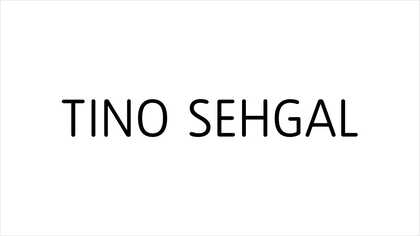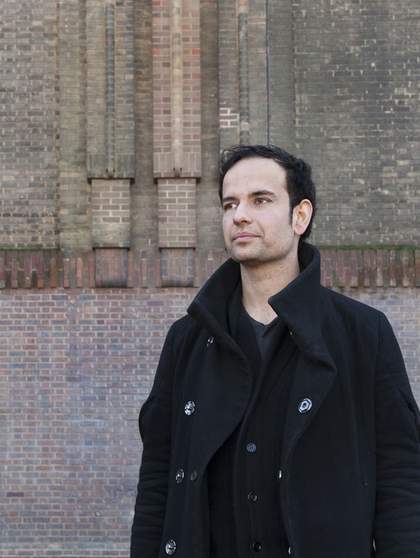If you think of art as a painting on a wall, a sculpture on the floor, or even a video projected on a screen, your first encounter with the art of Tino Sehgal probably came as a shock. Maybe it occurred in a grand but dilapidated house in Berlin, as you mounted a creaky staircase to find a couple locked in an embrace in a gilded ballroom. Or perhaps, arriving at the Guggenheim Museum in New York, you were accosted by a child who requested the pleasure of your company, and then, once you assented, asked ‘What is progress?’ while you ascended the ramp together. Alternatively, you might have walked into a gallery in Bangalore, interrupting six people who froze their conversation and declaimed, ‘Welcome to this situation!’, before resuming their discourse about Montaigne or world capitalism. But whatever the place, your reaction was probably the same: where’s the art?
In a career that is just a decade old, Sehgal, who is 36, has established himself as the art world’s foremost maestro of the immaterial. Paradoxically, his work is substantial and substantive, but it is totally without substance. He tackles real issues and evokes powerful thoughts and feelings, but he does so without fabricating any physical object that can be carried away. His art vanishes as soon as it is over, except for the impression that lingers like a footprint on your mind. Those who have not yet experienced his artistry will have the opportunity to do so this summer, when his latest work, the thirteenth annual commission in the Unilever Series, insinuates itself into Tate Modern’s lofty Turbine Hall.
Opening on 17 July, the piece will be on view until 28 October 2012, coinciding with the influx of visitors to the Olympics. Although the specifics are a tightly guarded secret, Jessica Morgan, The Daskalopoulos Curator, International Art, at Tate Modern, observes that Sehgal’s piece will evocatively echo the Games: ‘People will be doing things with their body, in parallel with what is going on in the city.’
Early in his career, Sehgal created pieces that were silent and sculptural. The best known is Kiss 2006, which is the work that the osculatory couple in Berlin was enacting. (Relatively simple to stage, it has since been seen in New York and Chicago.) A spectator who stumbles on it won’t at first realise what’s going on. It takes a minute or two to recognise that the performers are striking poses from such art works as Rodin’s 1886 sculpture of the same name and Jeff Koons’s ceramic Made in Heaven 1989–91. Meticulously choreographed, the piece unspools in a continuous loop, as the two actors segue from one pose into another, without emphasising any particular position, until they announce: ‘Tino Sehgal. Kiss. 2002.’ And then they begin again.
More recently, Sehgal has been creating what he calls ‘constructed situations’, in which audience members interact with the performers (he refers to them as ‘interpreters’) and participate in the realisation of the piece. This Progress, which was first seen at the Institute of Contemporary Arts (ICA) in London in 2006 and restaged at the Guggenheim in 2010, is a good example. As a visitor proceeds through the museum, he or she is engaged by four interlocutors – a child, an adolescent, a prime-of-life adult and, finally, an older person. The conversation that began with the child’s simple question – ‘What is progress?’ – advances into uncharted territory as the interpreters offer up things they have read recently or experiences from their lives, and the visitor responds. The magic of This Progress is that it often evokes the reaction – insight, delight, passion, confusion – that one hopes for in an encounter with a work of art. And it does so without the manufacture of any object, or the transformation of any material.
Sehgal’s strict abjuring of physical production distinguishes him from other conceptual artists, who typically document their ephemeral creations with something permanent – photographs, affidavits, catalogues, or other proofs. Philosophically, he is opposed to manufacturing more objects on a planet that is already overflowing with detritus: ‘My big question, which I think is the question of my generation, is that the way we produce nowadays, the social form of economic organisation, is not going to be able to persist, and we are going to be measured against the question of how we are able to adjust to that.’
Born in London to a father of Indian ancestry and a mother who is a German native, Sehgal spent much of his childhood on the move in Germany, as his father, a manager for IBM, was transferred to different cities. ‘He grew up in industrialised Germany surrounded by all this stuff that was being produced,’ says Catherine Wood, curator of contemporary art and performance at Tate Modern. ‘He didn’t want to add to it.’ He was attracted to dance physically, but the draw was also intellectual. ‘There is very little you can do without an object,’ he says. ‘Dance was a way of thinking out another mode of production practically for me. There is this activity which is producing something – which is something – but you do it only with yourself.’ The human body is the material being transformed.
At eighteen, Sehgal moved to Berlin, and in the same week began studying both dance and political economy. After a year, he relocated to Essen and continued his dual pursuits. His breakthrough came in 1999, when he composed a piece that he performed himself, naked, with only a light on a bare stage, called Twenty Minutes for the Twentieth Century. The work was actually 55 minutes long, during which time he enacted signature movements of twenty important choreographers. After he took it to a festival at the Moderna Museet in Stockholm, one appreciative spectator, the curator Jens Hoffmann, told him it was just like a museum of dance. ‘That is exactly what I was trying to do,’ Sehgal replied.
It was always clear to him that he was creating art, not dance, and that his work belonged in a museum or gallery, not a theatre. Unlike a performance, which takes place at a specified hour and has both a beginning and an end, Sehgal’s pieces are on display for the entire time that the institution is open to the public. There isn’t even an official opening, as with typical exhibitions. It’s installed, and then it’s there. Certain works can be adapted to a new physical space, just as a travelling exhibition will be rehung in different museums. ‘Tino’s work functions like sculpture, and every piece has volume and scale,’ says Yasmil Raymond, the curator of the Dia Art Foundation.
One of the frequent criticisms of Sehgal’s art might be called ‘the emperor’s new clothes’ diatribe: he is making a comfortable living by selling something that is as intangible as air. (His pieces are marketed in editions of three – with Sehgal retaining a fourth ‘artist’s proo’ – for upwards of £50,000 each.) But he is not the least bit defensive. He readily admits that he and his art reside within the economic system. How could they not? A father of two sons whom he is raising in Berlin with his partner, the art historian Dorothea von Hantelmann, Sehgal emphasises that unless you live in an environment where you produce everything you need by yourself, you must be able to create something of value to exchange with others.
The rigour of his method becomes blatantly apparent during a sale. Tate Modern’s purchase of This Is Propaganda 2002 was typical. The work is simple enough to describe. A visitor to a museum enters a gallery, and a guard begins to sing, in a mournful voice, ‘This is propaganda, you know, you know’, and concludes by announcing the author and title of the piece: ‘Tino Sehgal. This Is Propaganda. 2002.’ But the purchase in 2005 was anything but simple. Because nothing could be documented on paper, the transaction was conducted verbally in the presence of Sehgal, two of his dealers, two Tate curators and a lawyer for each side. ‘It was a real piece of theatre in itself,’ says Wood, who along with Morgan was representing the curatorial team. Six conditions placed on the installation of the work had been committed to memory and were duly recited. The museum discount price was stipulated. There was a discussion about how much money would be paid to the performer, and whether that sum would rise with inflation. A conservator discussed how the piece could be protected from degradation as it was passed down to future generations.
That Sehgal gets done whatever needs to be done is testament to his ability to operate in the world within his own stringent parameters. ‘It’s kind of extraordinary that he’s been able to create this way to exist in the art world,’ Wood says. ‘He’s managed to create a selling of experience in a world that is fetishistic about the selling of objects.’


